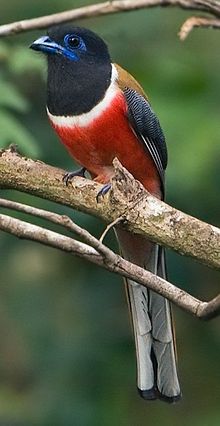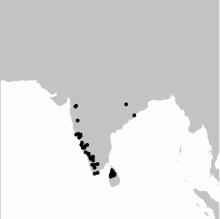Malabar trogon
| Malabar trogon | |
|---|---|
 |
|
| Male H. f. malabaricus | |
| Scientific classification | |
| Kingdom: | Animalia |
| Phylum: | Chordata |
| Class: | Aves |
| Order: | Trogoniformes |
| Family: | Trogonidae |
| Genus: | Harpactes |
| Species: | H. fasciatus |
| Binomial name | |
|
Harpactes fasciatus (Pennant, 1769) |
|
 |
|
| Synonyms | |
|
Harpactes malabaricus |
|
Harpactes malabaricus
The Malabar trogon (Harpactes fasciatus) is a species of bird in the trogon family. It is found in the forests of Sri Lanka and peninsular India. In India it is mainly found in the Western Ghats, hill forests of central India and in parts of the Eastern Ghats. They are insectivorous and although not migratory, may move seasonally in response to rain in hill forest regions. Like in other trogons, males and females vary in plumage. The birds utter low guttural call that can be heard only at close quarters and the birds perch still on a branch under the forest canopy with a hunched posture often facing away from the viewer making them easy to miss despite their colourful plumage.
Like most other trogons, these birds are brightly coloured and sexually dimorphic. The male has a slaty black head and breast with a white border to the black bib separating it from the crimson on the underside. The back is olive-brown to chestnut. The wing coverts are black with fine white vermiculations. They have 12 tail feathers that are graduated. The central tail-feathers are chestnut with a black tip, with the second and third pairs from the middle having more black than chestnut. The outer three pairs have long white tips. The female lacks the contrasting black and crimson and has only a slightly darker head and breast that shades into the olive brown on the back while the crimson of the underside of the male is replaced by ochre. In both sexes, the beak is bluish as is the skin around the eye. The iris is dark brown and the feet are pale bluish. The nostrils are covered by tufts of filoplumes. The feet are heterodactyl, a feature unique to the trogons, with the digits I and II facing back and digits III and IV pointing forward. In most birds I, II and III face forward while IV faces back and in zygodactyly II and III face forward while I and IV face backwards.
Several populations have been named. The central Indian subspecies legerli, named by Walter Norman Koelz on the basis of a single specimen obtained from the foot of Mahendra Giri in Orissa is not always recognized, but said to be slightly larger, longer winged and brighter than malabaricus of the Western Ghats. The nominate race found in the central wet zone of Sri Lanka is smaller and the upperparts are brighter.
These birds usually perch still, especially when alarmed and will sometimes clinging laterally to branches. When calling they sometimes raise and lower their tail. The call is a series of guttural or purring notes. The song of the male is a series of percussive kyau calls. The breeding season in India is mainly February to May (before the Monsoons) while it is March to June in Sri Lanka.
...
Wikipedia

